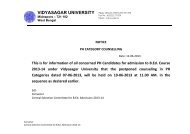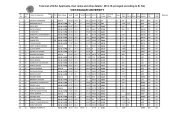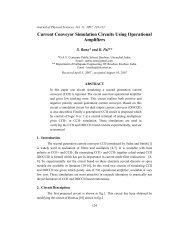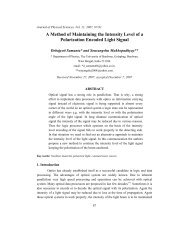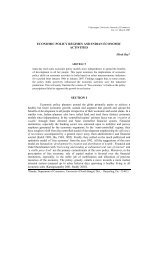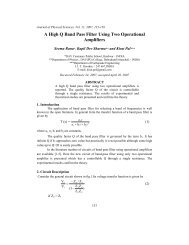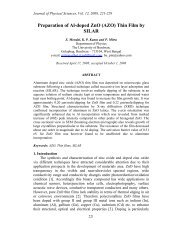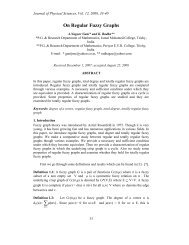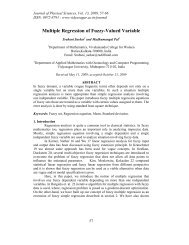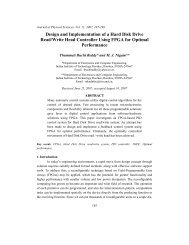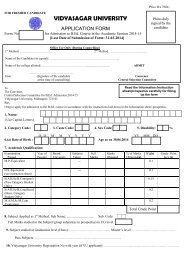VIDYASAGAR UNIVERSITY JOURNAL OF COMMERCE
VIDYASAGAR UNIVERSITY JOURNAL OF COMMERCE
VIDYASAGAR UNIVERSITY JOURNAL OF COMMERCE
Create successful ePaper yourself
Turn your PDF publications into a flip-book with our unique Google optimized e-Paper software.
SHG- BANKING IN INDIA-EMPIRICAL EVIDENCES <strong>OF</strong> BANKERS’ PERCEPTION AND PROBLEMS.<br />
This suggestion was received from some bankers during the course of the survey.<br />
Moreover programmes can be organised by DRDC with the representatives of<br />
different banks and Government officials to bring uniformity and simplicity in the<br />
documents required for banking activities.<br />
• Recognition for devotedness to SHG- banking can be given to employees in the<br />
form of awards, citations and highlighting performances in annual reports. This can<br />
act as a definite motivator for the bankers.<br />
• Problems of dearth of cooperation from the local bodies can be resolved by forming<br />
joint action committees at the local levels consisting of the bankers and the panchyat<br />
members. This will increase the frequency of their interactions, lead to better<br />
communication and assure timely cooperation.<br />
Microfinance and SHG-banking activities are multidimensional; therefore, strategies and<br />
policies often need to be framed not only on the basis of Government guidelines, but also on<br />
the basis of the local area characteristics, demographics and needs. The suggestions given<br />
above are broad based and need to be fine tuned according the requirements of each branch,<br />
number of SHGs linked to the branch and the staff working in the branch. A batch of<br />
motivated staff can be the pillars on which SHG- banking can sustain and facilitate<br />
microfinance systems to penetrate deep into the most poverty stricken segments of society.<br />
References<br />
1. Brugger, E.A. and Rajapatriana, S. (eds.) (1995): “ New perspectives on Financing Small<br />
Business In developing Countries”, ICS Press.<br />
2. Dasgupta, R. (2001): “Rural banking and credit - tale of many committees”. EPW,<br />
March.<br />
3. Fernandez, A.P. (1998): The MYRADA Experience: Alternative Management System<br />
for Savings and Credit of the Rural Poor, Mysore Resettlement and Development<br />
Agency, Bangalore.<br />
4. Harper, M. (1998): “Profit for the Poor - Cases in Micro-Finance”. Oxford and IBH<br />
Publishing Co. Ltd., New Delhi.<br />
5. Jayaraman, B (2001): “Micro Finance: Retrospect and Prospects”, Occasional Paper-20,<br />
National Bank for Agriculture and Rural Development, Mumbai.<br />
6. Karmakar, K. G. (1999): “ Rural Credit and SHG- Microfinance Needs and concepts in<br />
India”, Sage Publications India Pvt. Ltd., New Delhi.<br />
7. Kropp, E.W. and Suran,B.S, (2002): Linking Banks and Self Help Groups in India-An<br />
Assessment- Paper presented at the Seminar on SHG-bank Linkage Programme at New<br />
Delhi, 25 and 26 November, 2002<br />
8. Kulshrestha, Laxmi (2000): “Micro-finance: the new development paradigm for poor<br />
rural women”. Kurukshetra, November, 2000, pp. 22-25.<br />
9. Landy and Becker (1987): “Motivation Theory Reconsidered”, in L. Cummins and<br />
B.Staw (eds), Research in Organisational Behaviour, vol 9 (Greenwich, CT: JAI Press)<br />
p-12.<br />
64<br />
Vidyasagar University Journal of Commerce



